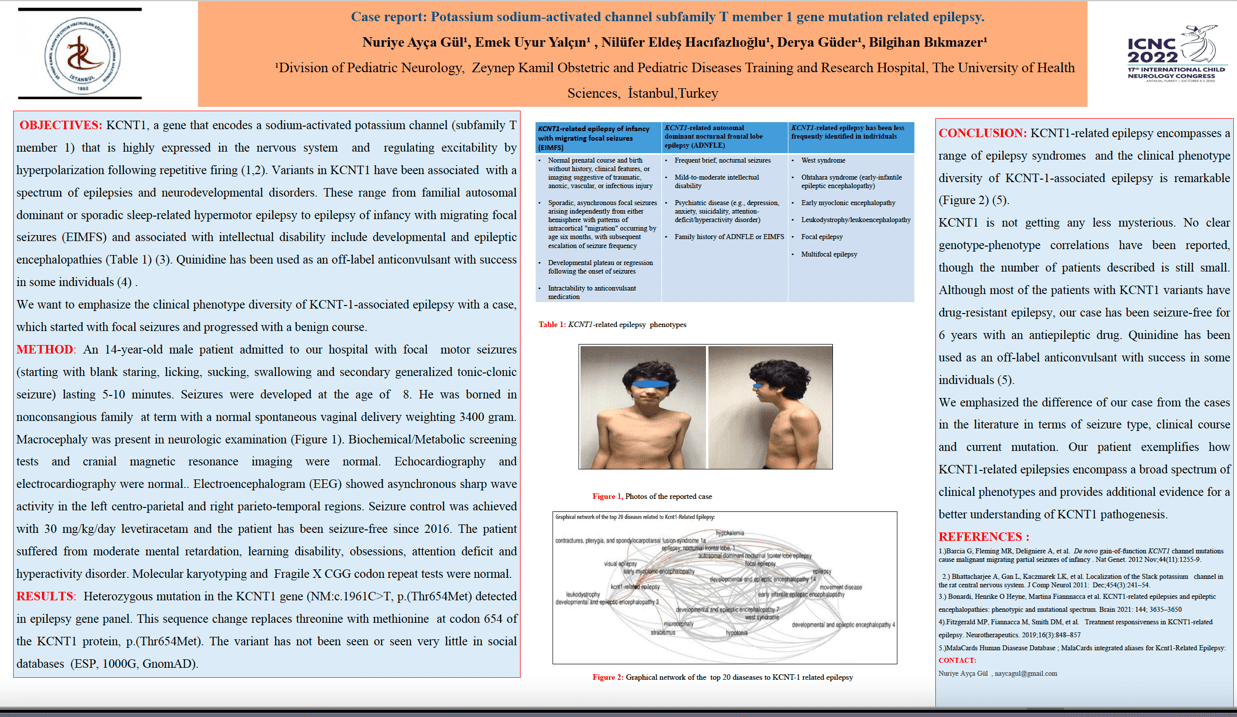Case report: Potassium sodium-activated channel subfamily T member 1 gene mutation related epilepsy.
Nuriye Ayca Gul, Emek Uyur Yalcın, Nilufer Eldes Hacıfazlioglu, Derya Guder, Bilgihan Bikmazer
Objectives: Potassium sodium-activated channel subfamily T member (KCNT1) gene mutations are inherited in an autosomal dominant manner and have been associated with epilepsy and neurodevelopmental disorders. We describe a patient with KCNT1 gene mutation related epilepsy and mental retardation. Methods: Eight years old patient admitted to our hospital with seizures (blank staring, licking, sucking, swallowing,generalised tonic clonic ) lasting between 5-10 minutes. The patient had moderate mental retardation, dyslexia, hyperactivity disorder. Cranial Magnetic Resonance imaging was normal. EEG showed asynchronous sharp wave activity in the left centroparietal and right parietotemporal regions. Clinical exome sequencing identified a heterozygous mutation in the KCNT1 gene (NM:c.1961C>T, p.(Thr654Met). The patient is seizure free with 30 mg/kg/day Levetiracetam treatment. RESULTS: KCNT1 gene encodes a sodium-activated potassium channel (KCN), regulating excitability in neurons. KCNs are highly expressed in the brain and regulates hyperpolarization following repetitive firing. KCNT1 gene encodes a sodium-gated potassium channel subunit that plays an important role in Variants in KCNT1-related epilepsy and associated with two phenotypes: epilepsy of infancy with migrating focal seizures and autosomal dominant nocturnal frontal lobe epilepsy. KCNT1-related epilepsy is often refractory to conventional anticonvulsants. Stiripenthol, benzodiazepines, levetiracetam, quinidine (off-label) can be used for treatment.
CONCLUSION: As most patients with KCNT1 variants have treatment-resistant epilepsy, we emphasized the difference of our case from the cases in the literature in terms of seizure type, clinical course and current mutation. This patient, exemplify how KCNT1-related epilepsies encompass a broad spectrum of clinical phenotype and provides additional evidence in understanding KCNT1 pathogenesis better.
Keywords: KCNT1 mutation, epilepsy, next-generation sequencing, levetiresetam
Nuriye Ayca Gul
Division of Paediatric Neurology, Zeynep Kamil Obstetric and Pediatric Diseases Training and Research Hospital, The University of Health Sciences, İ
Turkey
Emek Uyur Yalcın
Division of Paediatric Neurology, Zeynep Kamil Obstetric and Pediatric Diseases Training and Research Hospital, The University of Health Sciences, İs
Turkey
Nilufer Eldes Hacıfazlioglu
Division of Paediatric Neurology, Zeynep Kamil Obstetric and Pediatric Diseases Training and Research Hospital, The University of Health Sciences, İs
Turkey
Derya Guder
Division of Paediatric Neurology, Zeynep Kamil Obstetric and Pediatric Diseases Training and Research Hospital, The University of Health Sciences, İs
Turkey
Bilgihan Bikmazer
Division of Paediatric Neurology, Zeynep Kamil Obstetric and Pediatric Diseases Training and Research Hospital, The University of Health Sciences, İs
Turkey
Objectives: Potassium sodium-activated channel subfamily T member (KCNT1) gene mutations are inherited in an autosomal dominant manner and have been associated with epilepsy and neurodevelopmental disorders. We describe a patient with KCNT1 gene mutation related epilepsy and mental retardation. Methods: Eight years old patient admitted to our hospital with seizures (blank staring, licking, sucking, swallowing,generalised tonic clonic ) lasting between 5-10 minutes. The patient had moderate mental retardation, dyslexia, hyperactivity disorder. Cranial Magnetic Resonance imaging was normal. EEG showed asynchronous sharp wave activity in the left centroparietal and right parietotemporal regions. Clinical exome sequencing identified a heterozygous mutation in the KCNT1 gene (NM:c.1961C>T, p.(Thr654Met). The patient is seizure free with 30 mg/kg/day Levetiracetam treatment. RESULTS: KCNT1 gene encodes a sodium-activated potassium channel (KCN), regulating excitability in neurons. KCNs are highly expressed in the brain and regulates hyperpolarization following repetitive firing. KCNT1 gene encodes a sodium-gated potassium channel subunit that plays an important role in Variants in KCNT1-related epilepsy and associated with two phenotypes: epilepsy of infancy with migrating focal seizures and autosomal dominant nocturnal frontal lobe epilepsy. KCNT1-related epilepsy is often refractory to conventional anticonvulsants. Stiripenthol, benzodiazepines, levetiracetam, quinidine (off-label) can be used for treatment.
CONCLUSION: As most patients with KCNT1 variants have treatment-resistant epilepsy, we emphasized the difference of our case from the cases in the literature in terms of seizure type, clinical course and current mutation. This patient, exemplify how KCNT1-related epilepsies encompass a broad spectrum of clinical phenotype and provides additional evidence in understanding KCNT1 pathogenesis better.
Keywords: KCNT1 mutation, epilepsy, next-generation sequencing, levetiresetam
Nuriye Ayca Gul
Division of Paediatric Neurology, Zeynep Kamil Obstetric and Pediatric Diseases Training and Research Hospital, The University of Health Sciences, İ
Turkey
Emek Uyur Yalcın
Division of Paediatric Neurology, Zeynep Kamil Obstetric and Pediatric Diseases Training and Research Hospital, The University of Health Sciences, İs
Turkey
Nilufer Eldes Hacıfazlioglu
Division of Paediatric Neurology, Zeynep Kamil Obstetric and Pediatric Diseases Training and Research Hospital, The University of Health Sciences, İs
Turkey
Derya Guder
Division of Paediatric Neurology, Zeynep Kamil Obstetric and Pediatric Diseases Training and Research Hospital, The University of Health Sciences, İs
Turkey
Bilgihan Bikmazer
Division of Paediatric Neurology, Zeynep Kamil Obstetric and Pediatric Diseases Training and Research Hospital, The University of Health Sciences, İs
Turkey

Nuriye Ayca Gul
Division of Paediatric Neurology, Zeynep Kamil Obstetric and Pediatric Diseases Training and Research Hospital, The University of Health Sciences, İ Turkey
Division of Paediatric Neurology, Zeynep Kamil Obstetric and Pediatric Diseases Training and Research Hospital, The University of Health Sciences, İ Turkey